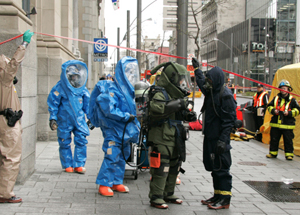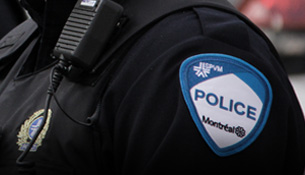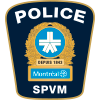Antiterrorism and emergency measures
The members of the Section antiterrorisme et mesures d'urgence closely follow all current news connected to terrorism and observe various large scale events to help them better address when emergency measures are needed. The Unit aims at being proactive rather than reactive.
The members are Police Officers who have the safety of montrealers and that of their colleagues called to intervene in major events at heart. They put all the pieces into place to offer the best Police answers to minimize the impact of a possible terrorist incident.
Their principal mandates:
- During a terrorist incident, the Commander is in charge of coordinating the event.
- The Unit is the leader in research and development connected to its field of expertise and establishes close ties with the many vital partners.
- It works out strategies and multi-organisational intervention protocols to be used if facing a terrorist threat.
- They advise management about terrorism issues.
- They coordinate the purchase of specialized equipment for various units of the Police Force.
- In matters when emergency measures must be implemented, under the aegis of civil security, the Unit ensures order, peace and public safety during non-criminal large scale events. They also make sure to maintain our services and work out the coordination of services during these situations.
Scene involving CBRNE
 The members are responsible to develop training scenarios for first responders, allowing them to intervene safely and effectively on any scene involving CBRNE (Chemical, Biological, Nuclear and Explosives events) elements. Training adapted to the needs of external partners is arranged to sensitize them and aims at preventing, detecting and at pushing back any possible threat.
The members are responsible to develop training scenarios for first responders, allowing them to intervene safely and effectively on any scene involving CBRNE (Chemical, Biological, Nuclear and Explosives events) elements. Training adapted to the needs of external partners is arranged to sensitize them and aims at preventing, detecting and at pushing back any possible threat.
Since March 1998, the Unit has directed the activities of the Comité aviseur antiterrorisme de Montréal (CAAM), whose objective is to improve the state of anti-terrorism intervener preparedness.
They also work on the flow of information, including the transportation of dangerous materials, the evacuation of the Ville de Montréal in the event of crisis, the deployment of Police Officers during a pandemic, the possibility of a plane crash, an overpowering heat wave, development and application of the plan developed in the "Plan québécois de lutte contre le terrorisme" (Quebec Plan to Fight Against Terrorism)", local intervention plans, etc.
Active shooter
The Section antiterrorisme et mesures d'urgence offers Active Shooter training to both private and public institutions such as schools, CEGEPs, universities, municipal Police bodies and people in charge of the safety of the health network or skyscrapers.
Following the shooting at Dawson College in 2006, the Coroner, referring to the SPVM program, recommended to organizations to better equip themselves in case of similar events. During the training, institutions improve their emergency measures plan by integrating a system with a special segment devoted to active shooters.



